|
The Butter Lamp Festival |
|
Also known as,
Lantern Festival or Chunga Choepa this festival is celebrated
on January 15 of the Tibetan calendar. This festival
originated when a noted patron of Tsong Khapa, illuminated
numerous butter- lamps in 1409 to honor the victory of
Sakyamuni in a debate over a non- Buddhist opponents.
According to Tibetan literalure, Tsong Khapa, dreamed that he
arrived at a hillside full of withered grasses and thorns, but
suddenly all the withered grasses became flowers and all the
thorns became bright lamps, among which all kinds of
jewelleries were shining brilliantly. Such a wonderful picture
mystified him and he commissioned monks to light butter lamps
before the sculpture of Sakyamuni and shape all kinds of
flowers and trees with colored butter and decorated with
jewelries to create a scene similar to his dream. This
tradition has been maintained to this day. Large scale butter
sculptures about stories of Buddha, figures, flowers, birds,
and animals are displayed and people sing and dance in great
joy throughout the night. The Barkhor street of Lhasa turns
into a grand exhibition site on the night of this festival.
|
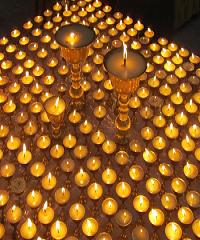 |
|
| |
|
The Ongkor Festival |
|
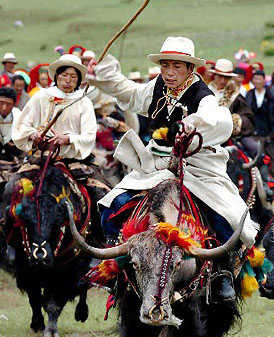 |
It is an old
festival in farming areas of Tibet. In Tibetan language “Ong”
refers to field and “kor” means rotating. So, “ongkor” means
walking round the field or surrounding the farmland. This
festival is commemorates by Tibetans to celebrate agricultural
harvest. The festival is held in each August according to
Tibetan calendar when all crops are waiting for harvest. The
“Ongkor”not only shows people’s wish for a good harvest, but
also a good time for them to rest. The Festival lasts for three
days, which entertain not only gods but also common human
beings. Farmers are plunged into a carnival at these days. On
the day, Tibetans dress themselves in holiday best and walk
around their fields, some carrying colorful flags, some lifting
barley and harvest pagoda made of ear of wheat with white hada
hanging around, some beating drums and gongs, singing songs and
Tibetan operas, some holding the portrait of Chairman Mao. After
that, people set up tents and take barley wines. They also hold
traditional activities and contests such as horse racing, yak
racing, shooting, riding to pick up hada, singing and dancing
contest and Tibetan opera contest, stone holding and wrestling.
|
|
| |
|
The Bathing Festival |
|
This festival is
celebrated in Lhasa. When Venus rises over the Holy Bottle
Mountain in the southeast, the Lhasans tell one another:
"The Bathing Festival begins." The Star appears only for
seven nights a year, and correspondingly the Bathing
Festival lasts for seven nights, too. This festival is held
from the 6th to the 12th day of the 7th Tibetan month. It is
believed when the sacred planet Venus appears in the sky;
the water in the river becomes purest and cures diseases.
During its appearance for one week in the sky, all the
people in Tibet take a ceremonial wash in the waters of
their
|
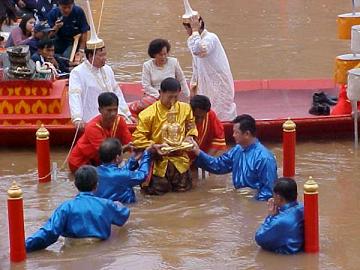 |
|
local
rivers or natural springs. Everybody, the young in particular,
go to rivers to take a holy bath. People will group together
according to sex. Obsessed with love for things they deem holy,
they do their best to wash away their troubles. Immersed in
water they feel an organic integration of soul and body with the
great nature. Tibetans have the strong belief that bathing for
the consecutive seven nights will enable them to keep off cold
and plague, and therefore enjoy good health and long life.
Having dipped in water for some time, they gather around the
bonfires that dot the world of willow trees, to dine and wine to
their heart's content. Then, they play six-stringed musical
instrument, sing folk songs and dance merrily. |
|
|
|
|
|
Saga Dawa Festival |
|
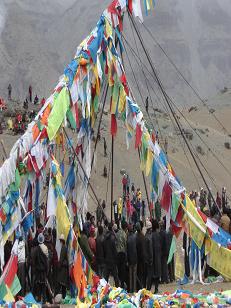 |
This is one of
the most important festivals for Tibetan Buddhism which is
celebrated to commemorates Shakyamuni's Buddhahood and the
death of his mortal body. It is celebrated on15th day of
the 4th lunar month of Tibetan calendar. This day is
considered holiest in Tibet as there memorable occasions
coincide on this day, Buddha's birth and Buddha's
enlightenment and Buddha’s Nirvana. Pilgrims and secular
folks visit Lhasa and the festival is observed by turning
prayer wheels, having vegetarian lunch and a picnic by the
Dragon King Pond. Folk entertainers perform Tibetan
tradition and pay their homage to Buddha. People observe a
vegetarian rule, refrain from killing domestic animals and
give out alms during the month. At every monastery sutras
are recited and 'Cham' dances are performed. It is said
that good deeds in the month of this festival deserve 300
fold in return and this leads many people to donate large
sums to the religious orders, monasteries and to the
beggars that gather at this time of year. |
|
| |
|
Losar
Festival |
|
Losar is the
most important Tibetan festival. In Tibetan language lo
means year and sar means new thus the word losar means
"new year” and losar festival is celebrated to commemorate
the advent of new year. It is the Ladakhi or Tibetan new
year. Losar is celebrated for 15 days during the month of
December and January as per the Tibetan lunar calendar.
The main celebrations are held on the first three days. On
the first day of Losar, a beverage called changkol, the
Tibetan rice wine is served which is made from chhaang.
The second day of Losar is known as King's Losar. Losar is
traditionally preceded by the five day practice of
Vajrakilaya. The losar is a colorful festival marked with
number of activities including ancient rituals, Tibetan
drama, making incense offerings, olk activities like,
wrestling, weight throwing, tug-of-war and horse-racing,
the stage fights between good & evil. The dance of the
Ibex deer and the dramatic battles between the King & his
ministers add to the joyous atmosphere. Tibetans are
dressed in their finest, meet their friends and relatives
and indulge in prayer and celebration. This festival is
full of music, dancing and merry-making.
|
|
Origin
The celebration of Losar can be traced back to the
pre-Buddhist period in Tibet. During the period when
Tibetans practiced the Bon religion, every winter a
spiritual ceremony was held, in which people used to
offer large quantities of incense to appease the local
spirits, deities and protectors. This religious
festival later evolved into an annual Buddhist
festival which is believed to have originated during
the reign of Pude Gungyal, the ninth King of Tibet.
Legends also said that the festival began when an old
woman named Belma introduced the measurement of time
based on the phases of the moon. |
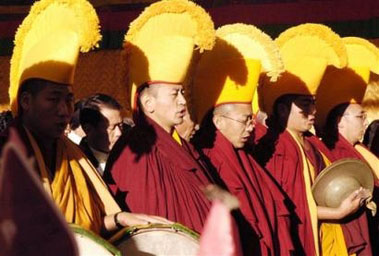 |
|
This festival
took place during the flowering of the apricot trees
of the Lhokha Yarla Shampo region in autumn, and it
may have been the first celebration of what has become
the traditional farmers' festival. It was during this
period that the arts of cultivation, irrigation,
refining iron from ore and building bridges were first
introduced in Tibet. The ceremonies which were
instituted to celebrate these new capabilities can be
recognized as precursors of the Losar festival. Later
when the rudiments of the science of astrology, based
on the five elements, were introduced in Tibet, this
farmer's festival became what we now call the Losar or
New Year's festival.
Rituals
For all Buddhists, Losar is a sacred time and a time for
feasting and celebration. It is a time when homes are
painted, new clothes are stitched, debts and quarrels are
resolved, good food is cooked and everyone indulge in
enjoyment. Homes are decorated with flour paintings of the
sun and moon, and small lamps illuminate the house at
night. The first few days of festivities are exclusively
family affairs, as are the first days of the new year. The
people visit friends and relatives, wish happy new near
and exchange gifts. Tibetans also visit monasteries and
make offerings to monks and nuns in form of food, clothes,
and other valuable items. Buddhist monks adorn the
monasteries with the finest decorations, and conduct
religious ceremonies. Rituals are performed to drive away
evil spirits, and people celebrate with feasts and
dancing. |
|
|
| |
|
Shoton
Festival |
|
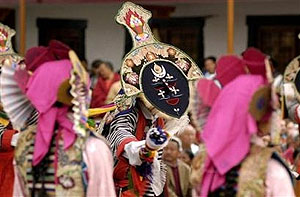 |
Also known as
Yoghurt Festival, this opera festival is one of the
greatest festivals in Tibet. Shoton is the transliteration
of two Tibetan words which mean 'Yoghurt Banquet'. The
festival originated at Drepung Monastery, when monks were
served with yoghurt at the completion of their hundred day
summer retreat. Legend also said that Tsong Khapa, the
founder of the Yellow Seat made it a rule that all the
Lamas must keep the mind on meditation from the fourth
month to the sixth month of Tibetan year. Abstinence is
broken by the end of sixth month. Then they may go
out and ordinary people would give them yoghurt in
charity and |
|
|
have picnic
and entertainment hence the festival. Later it became
theatrical festival of Tibetan opera. Prior to the
17th century, Shoton had been an exclusively religious
observance. From around the mid-17th century, Tibetan
local operas were added to festival celebrations which
were held around monasteries and in Lhasa the Drepung
Monastery. From the beginning of the 18th century, the
main site of the festival was moved to Norbu Lingka and
celebrations became formalized which include shining
of the Buddha's portrait, folk amusement at the local
park and performances of Tibetan operas. Popular fairs
are also organized during the festival. Today this is
the grandest festival in Tibet. |
|
This festival
begins on the new moon marking the end of the sixth
Tibetan month. At Drepung Monastery there are 'Cham'
dances and the grand thangka is unveiled early in the
morning. After devoutly viewing the thangka, the people go
onto the Norbulingka and other popular spots for a lingka
(picnic). Since 7th century, opera performances were held
for days in Norbu Lingka. Presently, opera contests and
distribution of prizes are held for seven days. The
performances include the musical dance dramas known as
Ache Lhamo (Tibetan Opera). The Ache Lhamo dances are
attributed to Thangtong Gyalpo, also known as |
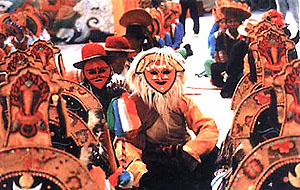 |
|
Chaksampa, a
lama of the fourteenth and fifteenth centuries, also
famous for building iron chain bridges in many parts of
Tibet. The popularity of this festival was such that the
government decreed it an annual event of a further five
days, established at the Norbulingka. There are
performances by all the established companies from
throughout Tibet, some of which can perform the whole
Lhamo repertoire, and some who specialize in one
particular drama. Some of the stories are derived from
Indian Buddhist legends, while others relate incidents
in Tibetan history. |
| |
|
During the
festival all the residents of Lhasa go out and gather in
the Norbulingka Park. They set up beautiful tents and hang
curtains there. They bring cakes, sweets, dairy products,
yak-butter tea and have wonderful picnics. Professional
and amateur Tibetan opera troupes gather in the
Norbulingka Park and perform various Tibetan operas. A
trade fair is also held during the festival.
|
|
|
|
|

